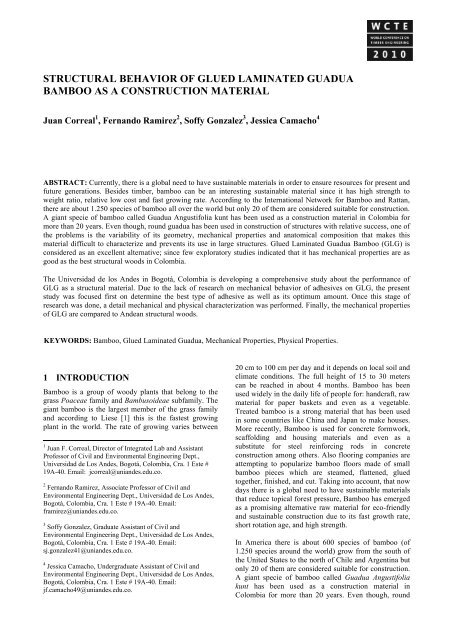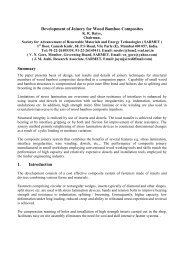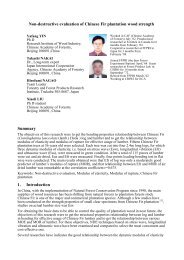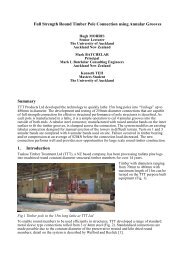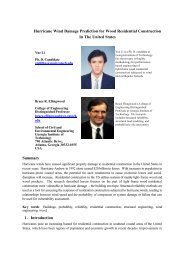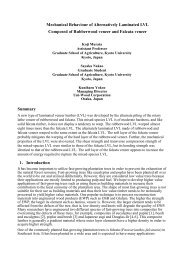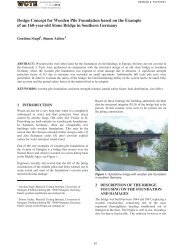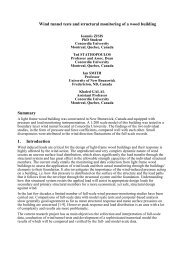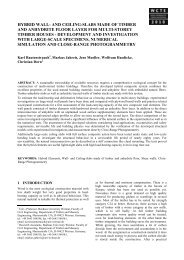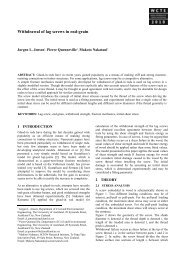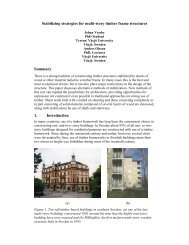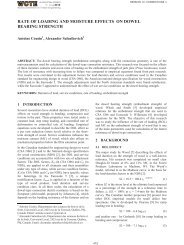structural behavior of glued laminated guadua bamboo as
structural behavior of glued laminated guadua bamboo as
structural behavior of glued laminated guadua bamboo as
Create successful ePaper yourself
Turn your PDF publications into a flip-book with our unique Google optimized e-Paper software.
STRUCTURAL BEHAVIOR OF GLUED LAMINATED GUADUA<br />
BAMBOO AS A CONSTRUCTION MATERIAL<br />
Juan Correal 1 , Fernando Ramirez 2 , S<strong>of</strong>fy Gonzalez 3 , Jessica Camacho 4<br />
ABSTRACT: Currently, there is a global need to have sustainable materials in order to ensure resources for present and<br />
future generations. Besides timber, <strong>bamboo</strong> can be an interesting sustainable material since it h<strong>as</strong> high strength to<br />
weight ratio, relative low cost and f<strong>as</strong>t growing rate. According to the International Network for Bamboo and Rattan,<br />
there are about 1.250 species <strong>of</strong> <strong>bamboo</strong> all over the world but only 20 <strong>of</strong> them are considered suitable for construction.<br />
A giant specie <strong>of</strong> <strong>bamboo</strong> called Guadua Angustifolia kunt h<strong>as</strong> been used <strong>as</strong> a construction material in Colombia for<br />
more than 20 years. Even though, round <strong>guadua</strong> h<strong>as</strong> been used in construction <strong>of</strong> structures with relative success, one <strong>of</strong><br />
the problems is the variability <strong>of</strong> its geometry, mechanical properties and anatomical composition that makes this<br />
material difficult to characterize and prevents its use in large structures. Glued Laminated Guadua Bamboo (GLG) is<br />
considered <strong>as</strong> an excellent alternative; since few exploratory studies indicated that it h<strong>as</strong> mechanical properties are <strong>as</strong><br />
good <strong>as</strong> the best <strong>structural</strong> woods in Colombia.<br />
The Universidad de los Andes in Bogotá, Colombia is developing a comprehensive study about the performance <strong>of</strong><br />
GLG <strong>as</strong> a <strong>structural</strong> material. Due to the lack <strong>of</strong> research on mechanical <strong>behavior</strong> <strong>of</strong> adhesives on GLG, the present<br />
study w<strong>as</strong> focused first on determine the best type <strong>of</strong> adhesive <strong>as</strong> well <strong>as</strong> its optimum amount. Once this stage <strong>of</strong><br />
research w<strong>as</strong> done, a detail mechanical and physical characterization w<strong>as</strong> performed. Finally, the mechanical properties<br />
<strong>of</strong> GLG are compared to Andean <strong>structural</strong> woods.<br />
KEYWORDS: Bamboo, Glued Laminated Guadua, Mechanical Properties, Physical Properties.<br />
1 INTRODUCTION 1234<br />
Bamboo is a group <strong>of</strong> woody plants that belong to the<br />
gr<strong>as</strong>s Poaceae family and Bambusoideae subfamily. The<br />
giant <strong>bamboo</strong> is the largest member <strong>of</strong> the gr<strong>as</strong>s family<br />
and according to Liese [1] this is the f<strong>as</strong>test growing<br />
plant in the world. The rate <strong>of</strong> growing varies between<br />
1 Juan F. Correal, Director <strong>of</strong> Integrated Lab and Assistant<br />
Pr<strong>of</strong>essor <strong>of</strong> Civil and Environmental Engineering Dept.,<br />
Universidad de Los Andes, Bogotá, Colombia, Cra. 1 Este #<br />
19A-40. Email: jcorreal@uniandes.edu.co.<br />
2 Fernando Ramirez, Associate Pr<strong>of</strong>essor <strong>of</strong> Civil and<br />
Environmental Engineering Dept., Universidad de Los Andes,<br />
Bogotá, Colombia, Cra. 1 Este # 19A-40. Email:<br />
framirez@uniandes.edu.co.<br />
3 S<strong>of</strong>fy Gonzalez, Graduate Assistant <strong>of</strong> Civil and<br />
Environmental Engineering Dept., Universidad de Los Andes,<br />
Bogotá, Colombia, Cra. 1 Este # 19A-40. Email:<br />
sj.gonzalez41@uniandes.edu.co.<br />
4 Jessica Camacho, Undergraduate Assistant <strong>of</strong> Civil and<br />
Environmental Engineering Dept., Universidad de Los Andes,<br />
Bogotá, Colombia, Cra. 1 Este # 19A-40. Email:<br />
jf.camacho49@uniandes.edu.co.<br />
20 cm to 100 cm per day and it depends on local soil and<br />
climate conditions. The full height <strong>of</strong> 15 to 30 meters<br />
can be reached in about 4 months. Bamboo h<strong>as</strong> been<br />
used widely in the daily life <strong>of</strong> people for: handcraft, raw<br />
material for paper b<strong>as</strong>kets and even <strong>as</strong> a vegetable.<br />
Treated <strong>bamboo</strong> is a strong material that h<strong>as</strong> been used<br />
in some countries like China and Japan to make houses.<br />
More recently, Bamboo is used for concrete formwork,<br />
scaffolding and housing materials and even <strong>as</strong> a<br />
substitute for steel reinforcing rods in concrete<br />
construction among others. Also flooring companies are<br />
attempting to popularize <strong>bamboo</strong> floors made <strong>of</strong> small<br />
<strong>bamboo</strong> pieces which are steamed, flattened, <strong>glued</strong><br />
together, finished, and cut. Taking into account, that now<br />
days there is a global need to have sustainable materials<br />
that reduce topical forest pressure, Bamboo h<strong>as</strong> emerged<br />
<strong>as</strong> a promising alternative raw material for eco-friendly<br />
and sustainable construction due to its f<strong>as</strong>t growth rate,<br />
short rotation age, and high strength.<br />
In America there is about 600 species <strong>of</strong> <strong>bamboo</strong> (<strong>of</strong><br />
1.250 species around the world) grow from the south <strong>of</strong><br />
the United States to the north <strong>of</strong> Chile and Argentina but<br />
only 20 <strong>of</strong> them are considered suitable for construction.<br />
A giant specie <strong>of</strong> <strong>bamboo</strong> called Guadua Angustifolia<br />
kunt h<strong>as</strong> been used <strong>as</strong> a construction material in<br />
Colombia for more than 20 years. Even though, round
Guadua h<strong>as</strong> been used in construction <strong>of</strong> structures with<br />
relative success, one <strong>of</strong> the problems is the variability <strong>of</strong><br />
its geometry, mechanical properties and anatomical<br />
composition that makes this material difficult to<br />
characterize and prevents its use in large structures.<br />
Glued Laminated Guadua Bamboo (GLG) is considered<br />
<strong>as</strong> an excellent alternative; since some exploratory<br />
studies [2-4] indicated that it h<strong>as</strong> mechanical properties<br />
<strong>as</strong> good <strong>as</strong> the best <strong>structural</strong> woods in Colombia. The<br />
Universidad de los Andes in Bogotá, Colombia is<br />
developing a comprehensive study about the<br />
performance <strong>of</strong> GLG <strong>as</strong> a <strong>structural</strong> material. Due to the<br />
lack <strong>of</strong> research on mechanical <strong>behavior</strong> <strong>of</strong> adhesives on<br />
GLG, the present study w<strong>as</strong> focused first on determine<br />
the best type <strong>of</strong> adhesive <strong>as</strong> well <strong>as</strong> its optimum amount.<br />
After completion <strong>of</strong> this stage <strong>of</strong> research, a detail<br />
mechanical and physical characterization w<strong>as</strong> performed.<br />
This paper present preliminary mechanical and physical<br />
characterization <strong>of</strong> GLG b<strong>as</strong>ed on the adhesive type and<br />
optimum adhesive spread rate found in the first stage <strong>of</strong><br />
this research. Also, a comparison <strong>of</strong> mechanical<br />
properties <strong>of</strong> GLG with Andean <strong>structural</strong> woods is<br />
established.<br />
2 MATERIALS AND PRODUCTION<br />
METHOD<br />
2.1 MATERIALS<br />
The main parts <strong>of</strong> the Guadua, the rhizomes and the<br />
culms are shown in Figure 1 a). The height <strong>of</strong> the culm<br />
varies from 20 to 30 meters and it can be separated into<br />
five parts each <strong>of</strong> them from 4 to 5 meters <strong>of</strong> length<br />
which are: cepa, b<strong>as</strong>a, sobreb<strong>as</strong>a, varillón and copo. The<br />
structure <strong>of</strong> the culm consisted <strong>of</strong> a cylindrical wall with<br />
a diaphragm nodal region is shown in Figure 1 b). The<br />
internode at the Cepa is about 10 cm and incre<strong>as</strong>es at the<br />
Varrillón to 40 cm. Guadua culms diameter varies from<br />
10 to 18 cm at the Cepa and 5 to 10 cm at Varillón and<br />
its thickness is 0.5 cm at Varillón and 2 cm at Cepa. The<br />
age <strong>of</strong> the mature Guadua is difficult to estimate. So far<br />
there are not studies about the optimal age that give<br />
optimal strength. Nevertheless and b<strong>as</strong>ed on the color <strong>of</strong><br />
the culm and p<strong>as</strong>t experience, the age <strong>of</strong> the culms for<br />
construction is selected between 3 to 4 year old.<br />
For the currently study, three to four year old Guadua<br />
<strong>bamboo</strong> culms with and average b<strong>as</strong>e diameter <strong>of</strong> 12 cm<br />
to 16 cm were obtained from Caidedonia-Valle in<br />
Colombia located at 1400 meters in elevation. In order to<br />
have culms with some kind <strong>of</strong> regular cross section, only<br />
the three bottoms parts (cepa, b<strong>as</strong>a, sobreb<strong>as</strong>a) were<br />
taken from the Guadua <strong>bamboo</strong> (Figure 1(a)). The length<br />
<strong>of</strong> each part (cepa, b<strong>as</strong>a, sobreb<strong>as</strong>a) w<strong>as</strong> approximately 5<br />
meters. The average thickness <strong>of</strong> the culm walls varied<br />
from 0.7 cm to 2.9 cm (Figure 1(b)). In order to ship the<br />
Guadua culms to the warehouse <strong>of</strong> the factory, each<br />
culm w<strong>as</strong> cut into 2 to 3 meters long pieces.<br />
The following adhesives were used in the fabrication<br />
process <strong>of</strong> GLG: Polymer 216 FE L (Fenol-Resorcinol-<br />
Formaldehyde Adhesive) Polymer 103 (Melamine Urea<br />
Adhesive), MUF 1242 (Melamine Urea Formaldehyde<br />
Adhesive) and 50% Polymer 216 FE L with 50 %<br />
Polymer 103.<br />
(a) Guadua plant<br />
(b) Guadua culm parts<br />
Figure 1: General parts <strong>of</strong> <strong>guadua</strong><br />
2.2 PRODUCTION METHOD<br />
The manufacture <strong>of</strong> the <strong>laminated</strong> Guadua w<strong>as</strong><br />
performed in Col<strong>guadua</strong> Ltda factory. The culms <strong>of</strong> 2m<br />
to 3m long were cut again into 1m to 1.5m in order to<br />
have straight pieces. Each piece is split in the radial<br />
direction into proper number <strong>of</strong> slices and the node<br />
sections are removed. The qu<strong>as</strong>i-flattened Guadua slices<br />
are p<strong>as</strong>sed through a grinding machine to remove the<br />
inner and outer layers. These slices are then immersed in<br />
a chemical solution to protect <strong>bamboo</strong> against insects<br />
attack, and then dried in an oven at 80 o C to reach an<br />
average moisture content <strong>of</strong> 5%. Once the slices are<br />
dried, their four faces are polished with a machine to
flatten their surfaces obtaining Guadua laminae. Each<br />
Guadua lamina is about 7mm to 10 mm thick, 20mm to<br />
25 mm wide, and 1 m to 1.5 m long. All laminae are<br />
impregnated with adhesive resin along the narrow face<br />
(Figures 2(a) and 2(b)) and stacked to form Guadua<br />
sheeting. A hot press at 100 o C with a lateral pressure <strong>of</strong><br />
1.2 MPa is applied to the laminae. Once the adhesive is<br />
cured, the Guadua sheets are <strong>glued</strong> together by the wide<br />
faces in order to form boards in a hot press at a pressure<br />
<strong>of</strong> 2 MPa for 15 minutes at 100 o C.<br />
(a) Glued Laminated Guadua Manufacture<br />
(b) Local directions<br />
Figure 2: Fabrication process <strong>of</strong> <strong>glued</strong> <strong>laminated</strong> <strong>guadua</strong><br />
3 EXPERIMENTAL PROGRAM<br />
3.1 ADHESIVE CALIBRATION<br />
The test procedures selected for the adhesive calibration<br />
program were static bending and <strong>glued</strong> line shear. Five<br />
samples <strong>of</strong> each type (adhesive and spread rate) were<br />
tested on a MTS Universal Testing Machine in the<br />
Material Lab at the Universidad de Los Andes in Bogotá,<br />
Colombia. Due to the lack <strong>of</strong> <strong>glued</strong> <strong>laminated</strong> <strong>bamboo</strong><br />
standards tests, the specifications given by ASTM<br />
D1037 (2006) and D143 (2007) were used for <strong>glued</strong> line<br />
shear and the static bending tests, respectively. The<br />
adhesive calibration program consisted <strong>of</strong> two stages.<br />
The objective <strong>of</strong> stage I w<strong>as</strong> to determine the best<br />
adhesive from the point <strong>of</strong> view <strong>of</strong> its strength. For this<br />
stage four types <strong>of</strong> adhesive (Urea-Formaldehyde (UF),<br />
Melamine-Formaldehyde (MF), Melamine-Urea-<br />
Formaldehyde (MUF), and mixture <strong>of</strong> 50% <strong>of</strong> UF and<br />
50% MF) and two adhesive spread rate applied to the<br />
narrow (200 g/m 2 and 250 g/m 2 ) and wide (400 g/m 2 and<br />
450 g/m 2 ) faces <strong>of</strong> the laminae (Figure 2b) were selected.<br />
These spread rates were b<strong>as</strong>ed on the adhesive<br />
manufacturer specifications and recommendations. Once<br />
the best type <strong>of</strong> adhesive is selected b<strong>as</strong>ed on stage I<br />
results, stage II start to estimate the optimal spread rate.<br />
The spread rate used along the narrow faces w<strong>as</strong> half <strong>of</strong><br />
that used on the wide faces. The amount <strong>of</strong> adhesive on<br />
wide faces in g/m 2 w<strong>as</strong> 260, 280, 300, 400 and 450.<br />
3.2 MECHANICAL AND PHYSICAL<br />
CHARACTERIZATION<br />
The mechanical tests performed were: compression and<br />
tension parallel and perpendicular to grain, and shear<br />
parallel to grain, and bending. Since there are no<br />
standards developed for <strong>glued</strong> <strong>laminated</strong> <strong>bamboo</strong>,<br />
ASTM D 143-94 [5] were used to perform mechanical<br />
tests. All the tests were conducted on a MTS Universal<br />
Testing Machine at the Materials Lab at the Universidad<br />
de Los Andes in Bogotá, Colombia. Temperature,<br />
moisture content, and relative humidity were recorded<br />
for all specimens. Besides density, radial, tangent and<br />
longitudinal toughness and contraction were the physical<br />
properties determined in this study following the ASTM<br />
D 2395-97 [6]. Twenty samples were used on each<br />
mechanical and physical test. Test procedures <strong>of</strong> the<br />
mechanical and physical properties are summarized <strong>as</strong><br />
follows:<br />
3.1.1 Compression parallel to grain<br />
The specimens were 50 mm by 50 mm in section and<br />
200 mm in length <strong>as</strong> shown in Figure 3 w<strong>as</strong> used. A<br />
continuous compressive load with a 0.6mm/min load rate<br />
w<strong>as</strong> applied. The load-displacement curve w<strong>as</strong> recorded<br />
and the el<strong>as</strong>ticity modulus (MOE), proportional limit<br />
stress, and ultimate stress were determined.<br />
Figure 3: Compression parallel to grain specimen and<br />
test setup<br />
3.1.2 Compression perpendicular to grain<br />
The specimens were 50 by 50 mm in section and 150<br />
mm in length. A MTS load frame with a 50 mm width<br />
bearing metal plate w<strong>as</strong> used to apply a continuous<br />
compressive load with a 0.3mm/min load rate. The load<br />
w<strong>as</strong> applied until a deformation equal to 5% <strong>of</strong> the<br />
specimen thickness w<strong>as</strong> reached, and the stress at that<br />
point w<strong>as</strong> calculated. The proportional limit stress w<strong>as</strong><br />
determined.
3.1.3 Tension parallel to grain<br />
Figure 4 shows the test setup. The load w<strong>as</strong> applied<br />
continuously throughout the test at a rate <strong>of</strong> 0.9 mm/min.<br />
The load-displacement curve w<strong>as</strong> recorded and the<br />
el<strong>as</strong>ticity modulus (MOE), proportional limit stress, and<br />
ultimate stress were determined.<br />
Figure 4: Tension parallel to grain test setup<br />
3.1.4 Tension perpendicular to grain<br />
Figure 5 shows the dimensions <strong>of</strong> the tensile test<br />
specimen. The load w<strong>as</strong> applied continuously throughout<br />
the test at a 2.5 mm/min rate <strong>of</strong> the movable crosshead.<br />
Ultimate tensile stress w<strong>as</strong> calculated.<br />
Figure 5: Specimen <strong>of</strong> tensile perpendicular to grain test<br />
3.1.5 Flexural strength<br />
The specimens were 25 by 25 mm in section and 410<br />
mm in length. The test setup is shown in Figure 5. The<br />
load w<strong>as</strong> applied at the center <strong>of</strong> a 350 mm span with a<br />
2.5mm/min load rate. The failure load w<strong>as</strong> recorded and<br />
the rupture module (MOR) w<strong>as</strong> calculated.<br />
Figure 6: Flexural Strength test setup<br />
3.1.6 Shear strength parallel to grain<br />
Dimensions <strong>of</strong> the test specimen, <strong>as</strong> well <strong>as</strong> the test setup<br />
are shown in Figure 6. The load w<strong>as</strong> applied<br />
continuously throughout the test at a 0.6 mm/min rate.<br />
Ultimate shear stress w<strong>as</strong> calculated.<br />
Figure 6: Specimen <strong>of</strong> shear strength parallel to grain<br />
test<br />
3.1.6 Hardness<br />
The specimens were 50 by 50 mm in section and 150<br />
mm in length. The load w<strong>as</strong> applied continuously<br />
throughout the test at a rate <strong>of</strong> motion <strong>of</strong> the movable<br />
crosshead <strong>of</strong> 6 mm/min. The load at which the ball<br />
penetrated to one half its diameter w<strong>as</strong> recorded.<br />
3.1.7 Specific gravity and shrinkage in volume<br />
Test specimens were regular in shape and had<br />
rectangular cross sections in order to enable the<br />
determination <strong>of</strong> volume through linear me<strong>as</strong>urement.<br />
Both specific gravity and shrinkage-in volume values<br />
were obtained from each specimen at about 12%<br />
moisture content <strong>of</strong> the samples in the oven-dried<br />
condition.
4 RESULTS AND DISCUSSION<br />
A total <strong>of</strong> two hundred samples were tested during the<br />
adhesive calibration program. A comparison <strong>of</strong> the bond<br />
shear strength for different types <strong>of</strong> adhesives using the<br />
spread rate specified by the manufacturer (stage I) is<br />
shown in Figure 7. Although the specimens with MUF<br />
adhesive exhibited slightly higher values <strong>of</strong> bond shear<br />
strength, there were no significant differences in this<br />
value among the four adhesives used. Moreover, the<br />
amount <strong>of</strong> the adhesive applied on the wide and narrow<br />
faces did not affect the value <strong>of</strong> bond shear strength.<br />
Similar <strong>behavior</strong> w<strong>as</strong> observed for the MOE and MOR<br />
obtained from the bending tests with different type <strong>of</strong><br />
adhesives and spread rates. Failure <strong>of</strong> the substrate<br />
(Guadua) w<strong>as</strong> observed in all the specimens <strong>of</strong> <strong>glued</strong> line<br />
shear and bending tests. It seems that the spread rate<br />
specified by the adhesive manufacturer w<strong>as</strong> on the<br />
conservative side producing failure the substrate.<br />
Since, all the adhesives behave well from the strength<br />
point <strong>of</strong> view and taking into account strength, durability<br />
and cost, the 50% UF +50% MF w<strong>as</strong> the adhesive<br />
selected from the stage I. The optimum amount <strong>of</strong><br />
adhesive spread rate at wide/narrow faces <strong>of</strong> 300/150<br />
g/m 2 w<strong>as</strong> selected since lower adhesive spread rate <strong>of</strong><br />
280/140 and 260/130 g/m2 presented a decre<strong>as</strong>e in bond<br />
shear strength <strong>of</strong> 27%.<br />
Figure 7: Bond shear strength for different types <strong>of</strong><br />
adhesives and spread rate.<br />
An average <strong>of</strong> 17.7 o C, 10.5 %, and 56.8% <strong>of</strong><br />
temperature, moisture content and relative humidity<br />
were recorded at the moment <strong>of</strong> the tests. Table 1<br />
presented the 5th percentiles <strong>of</strong> the results <strong>of</strong> the<br />
mechanical properties <strong>of</strong> GLG and the corresponding<br />
values <strong>of</strong> the <strong>structural</strong> wood according to Colombian<br />
Seismic Regulations NSR-1998 [7].<br />
The compression parallel to grain test showed a<br />
combination <strong>of</strong> crush with buckling failure for most <strong>of</strong><br />
the specimens. The 5% percentile value <strong>of</strong> the ultimate<br />
stress for CPAG is about two times more than the best<br />
Colombian wood (type A). The failure mode <strong>of</strong> the<br />
compression perpendicular to grain (CPEG) test w<strong>as</strong><br />
crushing <strong>of</strong> the material. Relatively low value <strong>of</strong> the 5 th<br />
percentile w<strong>as</strong> achieved in CPEG test compare to<br />
Colombian wood.<br />
Failure <strong>of</strong> the substrate (Guadua) w<strong>as</strong> observed in all the<br />
specimens <strong>of</strong> the tension perpendicular to grain (TPG)<br />
test. The glue-line shear test specimens failed in the<br />
interlaminate adhesive <strong>as</strong> expected. Bending test resulted<br />
in two main failure types: tension with compression and<br />
horizontal shear <strong>as</strong> shown in Figure 8 a) and b),<br />
respectively.<br />
(a) Tension and compression failure<br />
(b) Horizontal shear failure<br />
Table 1: Mechanical Strength Values <strong>of</strong> Glued<br />
Laminated Guadua and NSR-98 Wood Grades<br />
B<strong>as</strong>ed on Table 1, all the values <strong>of</strong> the mechanical<br />
properties <strong>of</strong> GLG are higher than those <strong>of</strong> the best<br />
<strong>structural</strong> wood grade (A). In most <strong>of</strong> the c<strong>as</strong>es, the<br />
mechanical properties <strong>of</strong> GLG are almost twice the<br />
values for all NSR-1998 [7] wood grades. In contr<strong>as</strong>t,<br />
average density <strong>of</strong> GLG is about the same than that <strong>of</strong><br />
<strong>structural</strong> wood grade A, since average density <strong>of</strong> GLG<br />
is 730 kg/m 3 where<strong>as</strong> average density <strong>of</strong> wood grade A<br />
is 710 kg/m 3 . Regarding toughness and contraction in<br />
GLG, an average toughness <strong>of</strong> 5832 N, and radial,<br />
tangent and longitudinal contraction <strong>of</strong> 4.03%, 3.48%<br />
and 0.33% were determined. Since fibers in <strong>bamboo</strong> are<br />
running along the <strong>bamboo</strong> culm, less contraction is<br />
expected in the longitudinal direction.
5 CONCLUSIONS<br />
B<strong>as</strong>ed on the preliminary results <strong>of</strong> this research, the<br />
following conclusions are drawn for Glued Laminated<br />
Guadua Bamboo:<br />
Although the specimens with MUF adhesive exhibited<br />
slightly higher values <strong>of</strong> bond shear strength, there were<br />
no significant differences in this value among the four<br />
adhesives used on this research, with the spread rate<br />
specified by the adhesive manufacturer.<br />
Bond shear strength is a good indicator <strong>of</strong> the optimal<br />
amount <strong>of</strong> adhesive to be used in any <strong>glued</strong> <strong>laminated</strong><br />
material. The optimal amount <strong>of</strong> adhesive is reached<br />
when bond shear strength is close to the strength <strong>of</strong> the<br />
substrate. Particularly for GLG, 300gr/m2 <strong>of</strong> adhesive<br />
applied on the wide faces and 150gr/m2 along the<br />
narrow faces is the optimum adhesive spread rate.<br />
Taking into account that the density <strong>of</strong> GLG is about the<br />
same that the best <strong>structural</strong> Colombian wood (grade A)<br />
and the mechanical properties <strong>of</strong> GLG are almost double<br />
than those <strong>of</strong> wood grade A, GLG can be a suitable<br />
material for construction and design <strong>of</strong> <strong>structural</strong><br />
elements<br />
ACKNOWLEDGEMENT<br />
The research presented in this paper is sponsored by the<br />
Ministry <strong>of</strong> Agriculture and Rural Development <strong>of</strong><br />
Colombia (Contract No 030-2007M3307-920-07),<br />
Universidad de los Andes and Col<strong>guadua</strong> Ltda. Thanks<br />
are to the staff <strong>of</strong> the Center <strong>of</strong> Research in Materials<br />
and Civil Works (CIMOC) and the Structural Lab<br />
Models at the Universidad de Los Andes in Bogotá,<br />
Colombia for their help and support.<br />
REFERENCES<br />
[1] Liese, W.: Research on <strong>bamboo</strong>. Wood Science and<br />
Technology, 21, pp. 189-209. 1987.<br />
[2] Lopez L, Correal J.: Exploratory study <strong>of</strong> the <strong>glued</strong><br />
<strong>laminated</strong> <strong>bamboo</strong> Guadua angustifolia <strong>as</strong> a<br />
<strong>structural</strong> material. Mader<strong>as</strong>-Ciencia y Tecnología,<br />
11 (3): 171-182. 2009<br />
[3] Duran, L.: Estudio de Guadua Laminada y su<br />
Aplicación al Sistema Tensegrity, Thesis Work in<br />
Architecture, Universidad Nacional de Colombia<br />
sede Bogotá, 2003.<br />
[4] Vaneg<strong>as</strong>, G.: Guadua Laminada Investigación,<br />
Experimentación y Aplicación, Thesis Work in<br />
Architecture, Universidad Nacional de Colombia<br />
sede Bogotá, 2003.<br />
[5] ASTM-D143-94, Standard Methods <strong>of</strong> Testing<br />
Small Clear Specimens <strong>of</strong> Timber, Sección 4, Vol<br />
4.1wood, July 1997.<br />
[6] ASTM-D2395-97, Standard Test Methods for<br />
Specific Gravity <strong>of</strong> Wood and Wood-B<strong>as</strong>ed<br />
Material, Sección 4, Vol 4.1wood, July 1997.<br />
[7] Asociación Colombiana de Ingeniería Sísmica,<br />
Norm<strong>as</strong> Colombian<strong>as</strong> de diseño sismorresistente<br />
(NSR-98), Asociación colombiana de Ingeniería<br />
Sísmica, Bogotá, Colombia, 1997.


